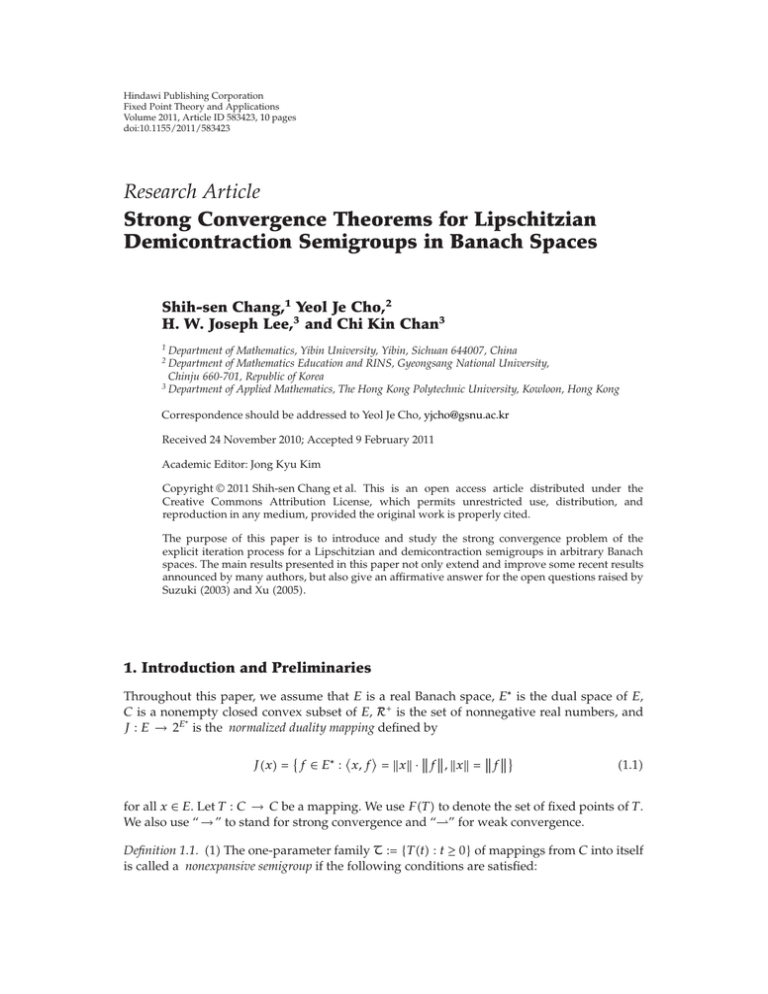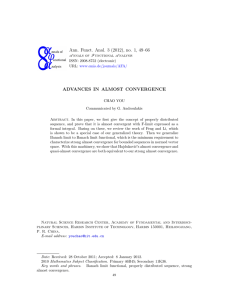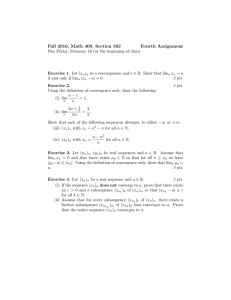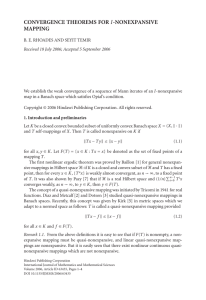Document 10884323
advertisement

Hindawi Publishing Corporation
Fixed Point Theory and Applications
Volume 2011, Article ID 583423, 10 pages
doi:10.1155/2011/583423
Research Article
Strong Convergence Theorems for Lipschitzian
Demicontraction Semigroups in Banach Spaces
Shih-sen Chang,1 Yeol Je Cho,2
H. W. Joseph Lee,3 and Chi Kin Chan3
1
Department of Mathematics, Yibin University, Yibin, Sichuan 644007, China
Department of Mathematics Education and RINS, Gyeongsang National University,
Chinju 660-701, Republic of Korea
3
Department of Applied Mathematics, The Hong Kong Polytechnic University, Kowloon, Hong Kong
2
Correspondence should be addressed to Yeol Je Cho, yjcho@gsnu.ac.kr
Received 24 November 2010; Accepted 9 February 2011
Academic Editor: Jong Kyu Kim
Copyright q 2011 Shih-sen Chang et al. This is an open access article distributed under the
Creative Commons Attribution License, which permits unrestricted use, distribution, and
reproduction in any medium, provided the original work is properly cited.
The purpose of this paper is to introduce and study the strong convergence problem of the
explicit iteration process for a Lipschitzian and demicontraction semigroups in arbitrary Banach
spaces. The main results presented in this paper not only extend and improve some recent results
announced by many authors, but also give an affirmative answer for the open questions raised by
Suzuki 2003 and Xu 2005.
1. Introduction and Preliminaries
Throughout this paper, we assume that E is a real Banach space, E∗ is the dual space of E,
C is a nonempty closed convex subset of E, R is the set of nonnegative real numbers, and
∗
J : E → 2E is the normalized duality mapping defined by
Jx f ∈ E∗ : x, f x · f , x f 1.1
for all x ∈ E. Let T : C → C be a mapping. We use FT to denote the set of fixed points of T.
We also use “ → ” to stand for strong convergence and “” for weak convergence.
Definition 1.1. 1 The one-parameter family T : {Tt : t ≥ 0} of mappings from C into itself
is called a nonexpansive semigroup if the following conditions are satisfied:
2
Fixed Point Theory and Applications
a T0x x for each x ∈ C;
b Tt sx TtTsx for any t, s ∈ R and x ∈ C;
c for any x ∈ C, the mapping t → Ttx is continuous;
d for any t ∈ R , Tt is a nonexpansive mapping on C, that is, for any x, y ∈ C,
Ttx − Tty ≤ x − y
1.2
for any t > 0.
2 The one-parameter family T : {Tt : t ≥ 0} of mappings from C into itself is
called a pseudocontraction semigroup if the conditions a–c and the following condition e
are satisfied:
e for any x, y ∈ C, there exists jx − y ∈ Jx − y such that
2
Ttx − Tty, j x − y ≤ x − y
1.3
for any t > 0.
3 A pseudocontraction semigroup T : {Tt : t ≥ 0} of mappings from C into itself
is said to be Lipschitzian if the conditions a–c, e, and the following condition f are
satisfied:
f there exists a bounded measurable function L : 0, ∞ → 0, ∞ such that, for any
x, y ∈ C,
Ttx − Tty ≤ Ltx − y
1.4
for any t > 0. In the sequel, we denote it by
L sup Lt < ∞.
t≥0
1.5
From the definitions, it is easy to see that every nonexpansive semigroup is a
Lipschitzian and pseudocontraction semigroup with Lt ≡ 1.
4 The one-parameter family T : {Tt : t ≥ 0} of mappings from C into itself is called
a strictly pseudocontractive semigroup if the conditions a–c and the following condition g
are satisfied:
g there exists a bounded function λ : 0, ∞ → 0, ∞ such that, for any given x, y ∈
C, there exists jx − y ∈ Jx − y such that
2
2
Ttx − Tty, j x − y ≤ x − y − λtI − Ttx − I − Tty
for any t > 0.
1.6
Fixed Point Theory and Applications
3
It is easy to see that such mapping is 1 λt/λt-Lipschitzian and pseudocontractive
semigroup.
5 The one-parameter family T : {Tt : t ≥ 0} of mappings from C into itself is
called a demicontractive semigroup if FTt / ∅ for all t > 0 and the conditions a–c and the
following condition h are satisfied:
h there exists a bounded function λ : 0, ∞ → 0, ∞ such that, for any t > 0, x ∈ C
and p ∈ FTt, there exists jx − p ∈ Jx − p such that
2
Ttx − p, j x − p ≤ x − p − λtI − Ttx2 .
1.7
In this case, we also say that T is a λt-demicontractive semigroup.
Remark 1.2. 1 It is easy to see that the condition 1.7 is equivalent to the following condition:
for any t > 0, x ∈ C and p ∈ FTt,
x − Ttx, j x − p ≥ λtx − Ttx2 .
1.8
∅ is demi2 Every strictly pseudocontractive semigroup with F : t≥0 FTt /
contractive and Lipschitzian.
The convergence problems of the implicit or explicit iterative sequences for nonexpansive semigroup to a common fixed has been considered by some authors in the settings of
Hilbert or Banach spaces see, e.g., 1–10.
In 1998, Shioji and Takahashi 7 introduced the following implicit iteration:
xn αn u 1 − αn σtn xn 1.9
for each n ≥ 1 in a Hilbert space, where {αn } is a sequence in 0, 1, {tn } is a sequence of
positive real numbers divergent to ∞, and, for any t > 0 and x ∈ C, σt x is the average given
by
1
σt x t
t
Tsxds.
1.10
0
Under certain restrictions to the sequence {αn }, they proved some strong convergence
theorems of {xn } to a point p ∈ F : t≥0 FTt.
In 2003, Suzuki 8 first introduced the following implicit iteration process for the
nonexpansive semigroup in a Hilbert space:
xn αn u 1 − αn Ttn xn
1.11
for each n ≥ 1. Under appropriate assumptions imposed upon the sequences {αn } and {tn },
he proved that the sequence {xn } defined by 1.11 converges strongly to a common fixed
point of the nonexpansive semigroup. At the same time, he also raised the following open
question.
4
Fixed Point Theory and Applications
Open Question 1.3 see 8. Does there exist an explicit iteration concerning Suzuki’s result?
That is, for any given x0 , u ∈ C, if we define an explicit iterative sequence {xn } by
x0 ∈ C,
xn1 αn u 1 − αn Ttn xn
1.12
for each n ≥ 0, what conditions to be imposed on {αn } ⊂ 0, 1 and {tn } ⊂ 0, ∞ are sufficient
to guarantee the strong convergence of {xn } to a common fixed point of the nonexpansive
semi-group T : {Tt : t ≥ 0} of mapping from C into itself?
In 2005, Xu 9 proved that Suzuki’s result holds in a uniformly convex Banach space
with a weakly continuous duality mapping. At the same time, he also raised the following
open question.
Open Question 1.4 see 9. We do not know whether or not the same result holds in a
uniformly convex and uniformly smooth Banach space.
In 2005, Aleyner and Reich 1 first introduced the following explicit iteration
sequence:
xn1 αn u 1 − αn Ttn xn
1.13
for each n ≥ 0 in a reflexive Banach space with a uniformly Gâteaux differentiable norm such
that each nonempty bounded closed and convex subset of E has the common fixed point
property for nonexpansive mappings note that all these assumptions are fulfilled whenever
E is uniformly smooth 11.
Also, under appropriate assumptions imposed upon the parameter sequences {αn }
and {tn }, they proved that the sequence {xn } defined by 1.13 converges strongly to some
point in F : t≥0 FTt.
Recently, in 2007, Zhang et al. 3 introduced the following composite iteration
scheme in the framework of reflexive Banach with a uniformly Gateaux differentiable
norm, uniformly smooth Banach space and uniformly convex Banach space with a weakly
continuous normalized duality mapping:
xn1 αn u 1 − αn yn ,
yn βn xn 1 − βn Ttn xn
1.14
for each n ≥ 0 for the nonexpansive semi-group T : {Tt : t ≥ 0} of mappings from C into
itself, where u is an arbitrary but fixed element in C and the sequences {αn } in 0, 1, {βn }
in 0, 1, {tn } in R , and proved some strong convergence theorems for the iteration sequence
{xn }. In fact, the results presented in 3 not only extend and improve the corresponding
results of Shioji and Takahashi 7, Suzuki 8, Xu 9, and Aleyner and Reich 1, but
also give a partially affirmative answer for the open questions raised by Suzuki 8 and
Xu 9.
In order to improve and develop the results mentioned above, recently, Zhang 12,
13, by using the different methods, introduce and study the weak convergence problem of
Fixed Point Theory and Applications
5
the implicit iteration processes for the Lipschitzian and pseudocontraction semigroups in
general Banach spaces. The results given in 12, 13 not only extend the above results, but
also extend and improve the corresponding results in Li et al. 6, Osilike 14, Xu and Ori
15, and Zhou 16.
The purpose of this paper is to introduce and study the strong convergence problem
of the following explicit iteration process:
x1 ∈ C,
1.15
xn1 1 − αn xn αn Ttn xn
for each n ≥ 1 for the Lipschitzian and demicontractive semigroup T : {Tt : t ≥ 0} in
general Banach spaces. The results presented in this paper improve, extend, and replenish
the corresponding results given in 1, 3–10, 12, 13.
In the sequel, we make use of the following lemmas for our main results.
∗
Lemma 1.5. Let J : E → 2E be the normalized duality mapping. Then, for any x, y ∈ E,
x y2 ≤ x2 2 y, j x y
1.16
for all jx y ∈ Jx y.
Lemma 1.6 see 17. Let {an } and {σn } be the sequences of nonnegative real numbers satisfying
the following condition:
an1 ≤ 1 σn an
1.17
for all n ≥ n0 , where n0 is some nonnegative integer. If ∞
n1 σn < ∞, then the limit limn → ∞ an
exists. In addition, if there exists a subsequence {ani } of {an } such that ani → 0, then limn → ∞ an 0.
2. Main Results
Now, we are ready to give our main results in this paper.
Theorem 2.1. Let E be a real Banach space; let C be a nonempty closed convex subset of E, and let
T : {Tt : t ≥ 0} : C → C be a Lipschitzian and demicontractive semigroup with a bounded
measurable function L : 0, ∞ → 0, ∞ and a bounded function λ : 0, ∞ → 0, ∞, respectively,
such that
L : sup Lt < ∞,
t≥0
λ : inf λt > 0,
t≥0
F :
t≥0
FTt /
∅.
2.1
6
Fixed Point Theory and Applications
Let {xn } be the sequence defined by 1.15, where {αn } is a sequence in 0, 1 and {tn } is an increasing
sequence in 0, ∞. If the following conditions are satisfied:
a
∞
n1
αn ∞,
∞
n1
α2n < ∞;
b for any bounded subset D ⊂ C,
lim
sup Ts tn x − Ttn x 0,
n → ∞x∈D,s∈R
2.2
then we have the following:
1 limn → ∞ xn − p exists for all p ∈ F.
2 lim infn → ∞ xn − Ttn xn 0.
Proof. 1 For any p ∈ F, we have
Ttn xn − p ≤ Ltn xn − p ≤ Lxn − p.
2.3
It follows from 2.3 that
xn1 − p ≤ 1 − αn xn − p αn Ttn xn − p
≤ 1 − αn αn Lxn − p
≤ 1 Lxn − p.
2.4
Consequently, it follows from 2.3 and 2.4 that
xn − Ttn xn ≤ xn − p p − Ttn xn ≤ 1 Lxn − p,
xn1 − Ttn xn1 ≤ xn1 − p p − Ttn xn1 ≤ 1 L2 xn − p.
2.5
2.6
From 2.5, we have
xn1 − xn αn Ttn xn − xn ≤ αn 1 Lxn − p.
2.7
Since T : {Tt : t ≥ 0} is an demicontractive semigroup with λ inft≥≥0 λt > 0, for the
points xn1 and p, there exists jxn1 − p ∈ Jxn1 − p such that
xn1 − Ttn xn1 , j xn1 − p ≥ λxn1 − Ttn xn1 2 .
2.8
Fixed Point Theory and Applications
7
Thus, by Lemma 1.5, 2.4, 2.7, and 2.8, we have
xn1 − p2 xn − p αn Ttn xn − xn 2
2
≤ xn − p 2αn Ttn xn − xn , j xn1 − p
2
xn − p 2αn Ttn xn − Ttn xn1 , j xn1 − p
− 2αn xn1 − Ttn xn1 , j xn1 − p 2αn xn1 − xn , j xn1 − p
2
≤ xn − p 2αn Lxn − xn1 xn1 − p
2.9
2
− 2αn λTtn xn1 − xn1 2 2α2n L1 L2 xn − p
2
≤ 1 2α2n 1 L3 xn − p − 2αn λTtn xn1 − xn1 2 .
This implies that
xn1 − p2 ≤ 1 2α2n 1 L3 xn − p2 .
2.10
2
By the assumption ∞
n1 αn < ∞, it follows from Lemma 1.6 that the limit limn → ∞ xn − p
exists and so the sequence {xn } is bounded in C.
2 We first prove that
lim inf xn1 − Ttn xn1 0.
n→∞
2.11
If it is not the case, suppose lim infn → ∞ xn1 − Ttn xn1 δ > 0. There exists a positive
integer n0 such that
xn1 − Ttn xn1 ≥
δ
2
2.12
for each n ≥ n0 . Since {xn } is bounded, denote by
M sup xn − p.
n≥1
2.13
Thus it follows from 2.9 that
xn1 − p2 ≤ xn − p2 − 2αn λTtn xn1 − xn1 2 2α2n 1 L3 xn − p2
2
δ2
≤ xn − p − αn λ 2α2n 1 L3 M2
2
2.14
8
Fixed Point Theory and Applications
for each n ≥ n0 . This implies that
αn λ
2 2
δ2 ≤ xn − p − xn1 − p 2α2n 1 L3 M2
2
2.15
for each n ≥ n0 . Hence, for each m > n0 , we have
λ
m
m m
δ2 xn − p2 − xn1 − p2 21 L3 M2
αn ≤
α2n
2 nn0
nn0
nn0
m
2
≤ xn0 − p 21 L3 M2
α2n .
2.16
nn0
Letting m → ∞ in 2.16, we have
λ
∞
∞
2
δ2 αn ≤ xn0 − p 21 L3 M2
α2n ,
2 nn0
nn0
2.17
∞
2
which is a contradiction since, by the condition a, ∞
n1 αn < ∞ and
n1 αn ∞. Therefore,
the conclusion 2.11 is proved.
On the other hand, since {xn } is bounded and {tn } is increasing, it follows from 2.11
and the condition b that
lim inf xn1 − Ttn1 xn1 n→∞
≤ lim inf {xn1 − Ttn xn1 Ttn1 xn1 − Ttn xn1 }
n→∞
lim inf {xn1 − Ttn xn1 Ttn1 − tn tn xn1 − Ttn xn1 }
n→∞
≤ lim inf xn1 − Ttn xn1 n→∞
sup
z∈{xn }, s∈R
2.18
Ts tn z − Ttn z
0.
This completes the proof.
By using Theorem 2.1, we have the following.
Theorem 2.2. Let E be a real Banach space; let C be a nonempty closed convex subset of E, and let
T : {Tt : t ≥ 0} of mappings from C into itself be a Lipschitzian and demicontractive semigroup
with a bounded measurable function L : 0, ∞ → 0, ∞ and a bounded function λ : 0, ∞ →
0, ∞, respectively, such that
L : sup Lt < ∞,
t≥0
λ : inf λt > 0,
t≥0
F :
t≥0
FTt /
∅.
2.19
Fixed Point Theory and Applications
9
Let {xn } be the sequence defined by 1.15, where {αn } is a sequence in 0, 1 and {tn } is an increasing
sequence in 0, ∞. If there exists a compact subset K of E such that t≥0 TtC ⊂ K and the
following conditions are satisfied:
∞ 2
a ∞
n1 αn ∞,
n1 αn < ∞;
b for any bounded subset D ⊂ C,
lim
sup Ts tn x − Ttn x 0,
n → ∞ x∈D,s∈R
2.20
then {xn } converges strongly to a common fixed point of the semigroup T : {Tt : t ≥ 0}.
Proof. By Theorem 2.1, we have lim infn → ∞ xn − Ttn xn 0. Again, by the assumption, it
follows that there exists a compact subset K ⊂ E such that t≥0 TtC ⊂ K and so there
exists a subsequence {xni } of {xn } such that
lim xnk − Ttnk xnk 0,
nk → ∞
lim Ttnk xnk q
nk → ∞
2.21
for some point q ∈ C. Hence it follows from 2.21 that xnk → q as nk → ∞.
Next, we prove that
lim Ttxnk − xnk 0
nk → ∞
2.22
for all t ≥ 0. In fact, it follows from the condition b and 2.21 that, for any t > 0,
Ttxnk − xnk ≤ Ttxnk − Tt tnk xnk Tt tnk xnk − Ttnk xnk Ttnk xnk − xnk ≤ 1 Lxnk − Ttnk xnk Tt tnk xnk − Ttnk xnk ≤ 1 Lxnk − Ttnk xnk sup
z∈{xn },s∈R
2.23
Ts tnk z − Ttnk z
−→ 0
as nk → ∞. Since xnk → q as nk → ∞ and the semigroup T : {Tt : t ≥ 0} is Lipschitzian,
it follows from 2.23 that q Ttq for all t ≥ 0, that is,
q ∈ F :
t≥0
FTt.
2.24
Since xnk → q as nk → ∞ and the limit limn → ∞ xn − q exists by Theorem 2.1 1, which
implies that xn → q ∈ F as n → ∞. This completes the proof.
Remark 2.3. Theorem 2.2 not only extends and improves the corresponding results of Shioji
and Takahashi 7, Suzuki 8, Xu 9, and Aleyner and Reich 1, but also gives an affirmative
answer to the open questions raised by Suzuki 8 and Xu 9.
10
Fixed Point Theory and Applications
Acknowledgment
The first author was supported by the Natural Science Foundation of Yibin University No.
2009Z3, and the second author was supported by the Korea Research Foundation Grant
funded by the Korean Government KRF-2008-313-C00050.
References
1 A. Aleyner and S. Reich, “An explicit construction of sunny nonexpansive retractions in Banach
spaces,” Fixed Point Theory and Applications, no. 3, pp. 295–305, 2005.
2 D. Boonchari and S. Saejung, “Construction of common fixed points of a countable family of λdemicontractive mappings in arbitrary Banach spaces,” Applied Mathematics and Computation, vol. 216,
no. 1, pp. 173–178, 2010.
3 S.-S. Zhang, L. Yang, and J.-A. L.u, “Strong convergence theorems for nonexpansive semi-groups in
Banach spaces,” Applied Mathematics and Mechanics, vol. 28, no. 10, pp. 1287–1297, 2007.
4 S. S. Chang, C. K. Chan, H. W. Joseph Lee, and L. Yang, “A system of mixed equilibrium problems,
fixed point problems of strictly pseudo-contractive mappings and nonexpansive semi-groups,”
Applied Mathematics and Computation, vol. 216, no. 1, pp. 51–60, 2010.
5 R. Chen, Y. Song, and H. Zhou, “Convergence theorems for implicit iteration process for a finite
family of continuous pseudocontractive mappings,” Journal of Mathematical Analysis and Applications,
vol. 314, no. 2, pp. 701–709, 2006.
6 S. Li, L. H. Li, and F. Su, “General iterative methods for a one-parameter nonexpansive semigroup in
Hilbert space,” Nonlinear Analysis: Theory, Methods & Applications, vol. 70, no. 9, pp. 3065–3071, 2009.
7 N. Shioji and W. Takahashi, “Strong convergence theorems for asymptotically nonexpansive
semigroups in Hilbert spaces,” Nonlinear Analysis: Theory, Methods & Applications, vol. 34, no. 1, pp.
87–99, 1998.
8 T. Suzuki, “On strong convergence to common fixed points of nonexpansive semigroups in Hilbert
spaces,” Proceedings of the American Mathematical Society, vol. 131, no. 7, pp. 2133–2136, 2003.
9 H.-K. Xu, “A strong convergence theorem for contraction semigroups in Banach spaces,” Bulletin of
the Australian Mathematical Society, vol. 72, no. 3, pp. 371–379, 2005.
10 S. S. Zhang, L. Yang, H. W. J. Lee, and C. K. Chan, “Strong convergence theorems for nonexpansive
semigroups in Hilbert spaces,” Acta Mathematica Sinica, vol. 52, no. 2, pp. 337–342, 2009.
11 F. E. Browder, “Nonlinear operators and nonlinear equations of evolution in Banach spaces,” in
Nonlinear Functional Analysis (Proc. Sympos. Pure Math., Vol. XVIII, Part 2, Chicago, Ill., 1968), pp. 1–
308, American Mathematical Society, Providence, RI, USA, 1976.
12 S.-S. Zhang, “Convergence theorem of common fixed points for Lipschitzian pseudo-contraction
semi-groups in Banach spaces,” Applied Mathematics and Mechanics, vol. 30, no. 2, pp. 145–152, 2009.
13 S. S. Zhang, “Weak convergence theorem for Lipschizian pseudocontraction semigroups in Banach
spaces,” Acta Mathematica Sinica, vol. 26, no. 2, pp. 337–344, 2010.
14 M. O. Osilike, “Implicit iteration process for common fixed points of a finite family of strictly
pseudocontractive maps,” Journal of Mathematical Analysis and Applications, vol. 294, no. 1, pp. 73–81,
2004.
15 H.-K. Xu and R. G. Ori, “An implicit iteration process for nonexpansive mappings,” Numerical
Functional Analysis and Optimization, vol. 22, no. 5-6, pp. 767–773, 2001.
16 H. Zhou, “Convergence theorems of common fixed points for a finite family of Lipschitz
pseudocontractions in Banach spaces,” Nonlinear Analysis: Theory, Methods & Applications, vol. 68, no.
10, pp. 2977–2983, 2008.
17 H. K. Xu, “Inequalities in Banach spaces with applications,” Nonlinear Analysis: Theory, Methods &
Applications, vol. 16, no. 12, pp. 1127–1138, 1991.




